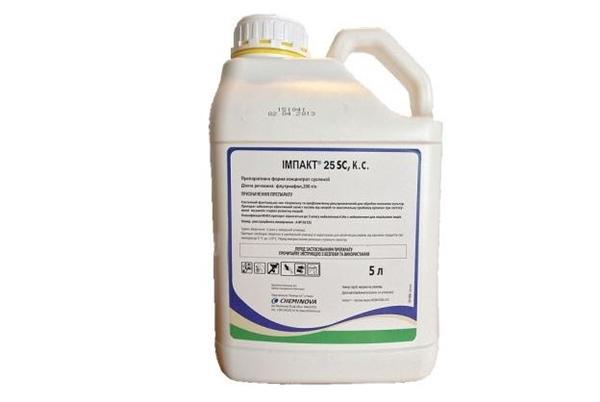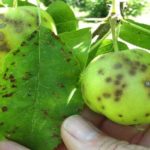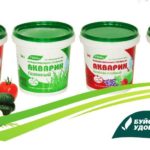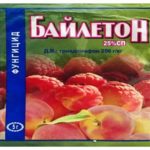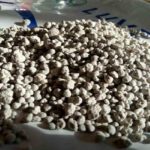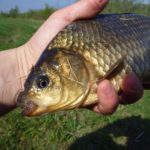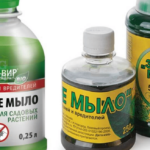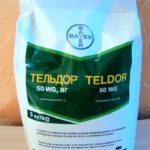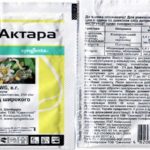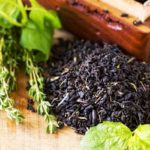Impact is a universal fungicide that is used to protect against fungal diseases of winter and spring varieties of cereals, beets, legumes, apple trees and grapes. It can deal with most types of rust, spotting and other fungi. When used correctly, this drug can both prevent and treat harmful pathogens.
- Composition and release form of fungicide Impact
- What can it handle and how does it work?
- Period of protective action and speed of exposure
- Pros and cons of the product
- Drug consumption rates
- Rules for preparing the working mixture
- Instructions for using the prepared solution
- Application of the drug to certain types of plants
- Precautions when using the drug
- Degree of toxicity of the fungicide
- Possibility of resistance
- Is it compatible with other drugs?
- Storing the product
- Analogs
Composition and release form of fungicide Impact
This fungicide contains the active ingredient flutriafol. The release form of the drug differs in the amount of the active element. There are 2 varieties:
- 12.5% active substance.
- 25% active substance.
What can it handle and how does it work?
Impact will help cope with diseases:
- rust (brown, yellow, stem);
- septoria;
- fusarium;
- helminthosporiosis (including brown and net spot);
- powdery mildew;
- pyrenophorosis;
- rhynchosporiosis.
Since the drug contains flutriafol, it is quickly absorbed into the plant and moves through its tissues. Because of this, it begins to work after it hits the surface of the leaves or trunk. After just 30 minutes, the drug is not washed off by water or rain.
Since Impact disperses inside the plant, it protects leaves that have not yet opened.
Period of protective action and speed of exposure
The drug begins to work 30 minutes after spraying it on the surface of the plant.
It also provides protection for crops or gardens for 1-1.5 months after use.
Pros and cons of the product
The advantages of the drug include:
- performance. Begins to work actively immediately after contact with plant tissue;
- preventive effects;
- long period of protection;
- effective against most fungal diseases;
- suitability for various plants;
- resistance to precipitation;
- compatibility with most fertilizers and pesticides;
- low toxicity to bees and humans;
- possibility of spraying using aviation.
Impact has 2 significant disadvantages:
- With prolonged and frequent treatment of the area, it causes immunity to fungal diseases.
- Contraindicated for spraying flowering plants.
Drug consumption rates
The amount of the drug required for various plants:
- 0.5-0.8 liters per 1 hectare for winter varieties;
- 0.7-1 liter per 1 hectare for sunflowers;
- 0.5-0.8 liters per 1 hectare for beets;
- 0.6-0.8 liters per 1 hectare for legume varieties;
- 0.7-1 liter per 1 hectare for rice.
For 1 season, you need to make 1-4 treatments, depending on the plants being treated. For aerial spraying, from 60 to 100 liters of mixture per 1 hectare is used.
Rules for preparing the working mixture
To prepare the solution you need:
- mix the drug thoroughly in the canister;
- dissolve 60-80 milliliters of the substance per 100 liters of water.
Instructions for using the prepared solution
Over a large area, the mixture is treated using a boom or fan sprayer. In small areas, a spray can be used for spraying, and in plantations and fields, aerial irrigation is used. Treatment with the drug should be carried out within 12 hours after mixing the solution.
When used against fusarium and septoria, fungicides containing benomyl or chlorothalonil should be added to the mixture. They increase the effectiveness of the drug and reduce the risk of the fungus developing immunity to it. If you add fungicides with morphalin to the solution, the substance’s protection against yellow rust will increase.
Application of the drug to certain types of plants
The use of the mixture differs depending on the irrigated crop:
- Grape. The drug is used in the treatment and prevention of Oidium.Treatment should be carried out when leaves appear and before flowering.
- Fruit trees. To prevent and treat scab and powdery mildew, treatment should be done before flowering and during fruit formation. When these diseases appear, trees should be treated once every 2 weeks.
- Cereals. When sprayed with this mixture, plant protection against most types of spotting, rust and other fungi in cereal varieties increases. Grain crops should be processed during the growing season.
- Sugar beet. The drug is used to protect and treat beets from powdery mildew, phomosis and cercospora. It needs to be processed once during the growing season.
Precautions when using the drug
Impact is not harmful to humans, but when used, general safety precautions for working with chemicals must be followed. It is necessary to avoid contact of the substance with the mucous membrane, eyes and respiratory tract.
Degree of toxicity of the fungicide
Impact is classified as toxicity category 3. It can be safely used near apiaries and ponds. This substance has low toxicity to humans.
Possibility of resistance
If used frequently in one area, the drug can cause resistance. To avoid this situation, you should alternate Impact with fungicides that have a different principle of action on fungal diseases.
Is it compatible with other drugs?
The drug is compatible with most fungicides (Dinadim Expert, Vantex). To increase the effectiveness of Impact, you should use mixtures that include:
- chlorothalonil (1 liter of substance per 1 hectare);
- benomyl (0.4-0.6 liters per 1 hectare).
Storing the product
Impact should be stored undiluted at temperatures from -10 °C to +30 °C. Direct sunlight must be avoided. The shelf life is 3 years from the date of manufacture. When using, you need to mix the canister thoroughly. The finished mixture should not be stored for more than 12 hours.
Analogs
Analogues of Impact are fungicides that contain flutriafol.
Such substances are:
- flutrivit;
- top effect;
- fulgor;
- paracel.







